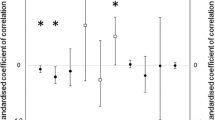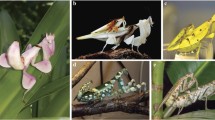Abstract
Many hypotheses have been proposed to account for the origin and maintenance of reversed size dimorphism (RSD, females being larger than males) in hawks, falcons and owls, but no consensus has been reached. I performed comparative analyses, using both cross-taxa data and phylogenetically independent contrasts, to investigate potential correlates of reversed size dimorphism. Using a similar set of explanatory variables, covering morphology, life history and ecology, I tested whether any trait coevolved with size dimorphism in all three groups and hence provided a general explanation for the evolution of RSD. For hawks, strong correlates were found in the foraging-variable complex, so RSD might have evolved in species hunting large and agile prey. This is consistent with the intersexual-competition hypothesis (sexes have evolved different sizes to lessen intersexual competition for food), but especially the small-male hypothesis (males have evolved to be smaller to be more efficient foragers). Evolutionary pathway analyses suggest that RSD evolved most likely as a precursor of changes in hunting strategy but as a consequence of high reproduction. The falcons showed a similar pattern: species with strong RSD hunted larger and more agile prey. The evolutionary pathway analysis supported the idea that RSD evolved before the specialisation on more agile and/or larger prey. Finally for owls, the results showed clear parallels. RSD increased with prey size, consistent with the small-male hypothesis. Evolutionary pathway analysis suggests that RSD in owls has most likely evolved before specialisation on large prey, so a small and more agile male might be advantageous even when hunting small prey. These results suggest that RSD in hawks, falcons and owls evolved due to natural-selection pressures rather than sexual-selection pressures.
Similar content being viewed by others
References
D. Amadon (1975) ArticleTitleWhy are female birds of prey larger than males? J. Raptor Res. 9 1–11
M. Andersson (1994) Sexual Selection Princeton University Press Princeton, NJ
M. Andersson R.A. Norberg (1981) ArticleTitleEvolution of reversed sexual size dimorphism and role partitioning among predatory birds, with a size scaling of flight performance Biol. J. Linn. Soc. 15 105–130
A. Arak (1988) ArticleTitleSexual dimorphism in body size: a model and a test Evolution 42 820–825
T.G. Balgooyen (1976) ArticleTitleBehaviour and ecology of the American kestrel (Falco sparverius) in the Sierra Nevada of California Univ. Cal. Publ. (Zoology) 103 1–83
T.G. Barraclough P.H. Harvey S. Nee (1995) ArticleTitleSexual selection and taxonomic diversity in passerine birds Proc. R. Soc. Lond. B 259 211–215
T.J. Cade (1982) The Falcons of the World Cornell University Press Ithaca NY
P. Catry R.A. Phillips R.W. Furness (1999) ArticleTitleEvolution of reversed sexual size dimorphism in skuas and jaegers Auk 116 158–168
F. Cezilly F. Dubois M. Pagel (2000) ArticleTitleIs mate fidelity related to site fidelity? A comparative analysis in Ciconiiforms Anim. Behav. 59 1143–1152 Occurrence Handle10.1006/anbe.2000.1422 Occurrence Handle10877893
R.K. Colwell (2000) ArticleTitleRensch’s rule crosses the line: convergent allometry of sexual size dimorphism in hummingbirds and flower mites Am. Nat. 156 495–510 Occurrence Handle10.1086/303406
C. Darwin (1871) The Descent of Man, and Selection in Relation to Sex John Murray London
D.J. Fairbairn (1997) ArticleTitleAllometry for sexual size dimorphism: pattern and process in the coevolution of body size in males and females Ann. Rev. Ecol. Syst. 28 659–687 Occurrence Handle10.1146/annurev.ecolsys.28.1.659
J. Felsenstein (1985) ArticleTitlePhylogenies and the comparative method Am. Nat. 125 1–15 Occurrence Handle10.1086/284325
J. Ferguson-Lees D.A. Christie (2001) Raptors of the World Christopher Helm London
J. Figuerola (1999) ArticleTitleA comparative study on the evolution of reversed size dimorphism in monogamous waders Biol. J. Linn Soc. 67 1–18 Occurrence Handle10.1006/bijl.1998.0254
M.K. Fowlie O. Krüger (2003) ArticleTitleThe evolution of plumage polymorphism in birds of prey and owls: the apostatic selection hypothesis revisited J. Evol. Biol. 16 577–583 Occurrence Handle10.1046/j.1420-9101.2003.00564.x Occurrence Handle14632221
Hair, J.F., Anderson, R.E., Tatham, R.L. and Black, W.C. (1995) Multivariate data analysis with readings. 4th edn. Prentice Hall, Englewood Cliffs, NJ
H. Hakkarainen E. Korpimäki (1991) ArticleTitleReversed sexual size dimorphism in Tengmalm’s owl: is small male size adaptive? Oikos 61 337–346
H. Hakkarainen E. Korpimäki (1993) ArticleTitleThe effect of female body size on clutch volume of Tengmalm’s owls (Aegolius funereus) in varying food conditions Orn. Fenn. 70 189–195
H. Hakkarainen E. Korpimäki (1995) ArticleTitleContrasting phenotypic correlations in food provision of male Tengmalm’s owls (Aegolius funereus) in a temporally heterogeneous environment Evol. Ecol. 9 30–37 Occurrence Handle10.1007/BF01237694
H. Hakkarainen E. Huhta K. Lahti P. Lundvall T. Mappes P. Tolonen J. Wiehn (1996) ArticleTitleA test of male mating and hunting success in the kestrel: the advantages of smallness? Behav. Ecol. Sociobiol. 39 375–380 Occurrence Handle10.1007/s002650050303
P.H. Harvey M. Pagel (1991) The Comparative Method in Evolutionary Biology Oxford University Press Oxford
P.H. Harvey A. Rambaut (2000) ArticleTitleComparative analyses for adaptive radiations Phil. Trans. R. Soc. Lond. B 355 1599–1605 Occurrence Handle10.1098/rstb.2000.0715
R.N. Holdaway (1994) An exploratory phylogenetic analysis of the genera of the Accipitridae, with notes on the biogeography of the family B.U. Meyburg R.D. Chancellor (Eds) Raptor Conservation Today Pica Press Berlin 601–647
D.F. Hoyt (1979) ArticleTitlePractical methods of estimating volume and fresh weight of bird eggs Auk 96 73–77
F.C. James C.E. McCulloch (1990) ArticleTitleMultivariate analysis in ecology and systematics: Panacea or Pandora´s box? Ann. Rev. Ecol. Syst. 21 129–166
J.R. Jehl B.G. Murray (1986) ArticleTitleThe evolution of normal and reverse sexual size dimorphism in shorebirds and other birds Curr. Ornithol. 3 1–86
K.J. Kissner P.J. Weatherhead C.M. Francis (2003) ArticleTitleSexual size dimorphism and timing of spring migration in birds J. Evol. Biol. 16 154–162 Occurrence Handle10.1046/j.1420-9101.2003.00479.x Occurrence Handle14635890
C. König F. Weick J.H. Becking (1999) Owls: A Guide to the Owls of the World Pica Press East Sussex
O. Krüger (2000) ArticleTitleCorrelates of population density and body weight of raptors in the family Accipitridae: a comparative study J. Zool. Lond. 250 185–192
O. Krüger N.B. Davies (2002) ArticleTitleThe evolution of cuckoo parasitism: a comparative analysis Proc. R. Soc. Lond. B 269 375–381 Occurrence Handle10.1098/rspb.2001.1887
P. Lindenfors T. Szekely J.D. Reynolds (2003) ArticleTitleDirectional change in sexual size dimorphism in shorebirds, gulls and alcids J. Evol. Biol. 16 930–938 Occurrence Handle10.1046/j.1420-9101.2003.00595.x Occurrence Handle14635908
S. Massemin E. Korpimäki J. Wiehn (2000) ArticleTitleReversed sexual size dimorphism in raptors: evaluation of the hypotheses in kestrels breeding in a temporally changing environment Oecologia 124 26–32 Occurrence Handle10.1007/s004420050021
B.H. McArdle (1988) ArticleTitleThe structural relationship: regression in biology Can. J. Zool. 66 2329–2339
H.C. Mueller (1986) ArticleTitleThe evolution of reversed sexual dimorphism in owls: an empirical analysis of possible selective factors Wilson Bull. 98 387–406
H.C. Mueller (1990) ArticleTitleThe evolution of reversed sexual dimorphism in size in monogamous species of birds Biol. Rev. 65 553–585
H.C. Mueller K. Meyer (1985) ArticleTitleThe evolution of reversed sexual dimorphism in size: a comparative analysis of the Falconiformes of the Western Palearctic Curr. Ornithol. 2 65–101
J.H. Myers (1978) ArticleTitleSex-ratio adjustment under food stress: maximisation of quality or numbers of offspring Am. Nat. 112 381–388 Occurrence Handle10.1086/283280
I. Newton (1979) Population Ecology of Raptors T. & A.D. Poyser London
R. Norberg (1987) Evolution, structure and ecology of northern forest owls R.W. Nero (Eds) Biology and Conservation of Northern Forest Owls USDA Fort Collins
P. Olsen A. Cockburn (1993) ArticleTitleDo large females lay small eggs? Sexual dimorphism and the allometry of egg and clutch volume Oikos 66 447–453
P. Olsen J. Olsen (1984) ArticleTitleBook review: the falcons of the world Austral. Wildl. Res. 11 205–206 Occurrence Handle10.1071/WR9840205
P. Olsen J. Olsen (1987) ArticleTitleSexual size dimorphism in raptors: intrasexual competition in the larger sex for a scarce breeding resource, the smaller sex Emu 87 59–62
I.P.F. Owens I.R. Hartley (1998) ArticleTitleSexual dimorphism in birds: why are there so many different forms of dimorphism? Proc. R. Soc. Lond. B 265 397–407 Occurrence Handle10.1098/rspb.1998.0308
M. Pagel (1994) ArticleTitleDetecting correlated evolution on phylogenies: a general method for the comparative analysis of discrete characters Proc. R. Soc. Lond. B 255 37–45
M. Pagel (1999) ArticleTitleInferring the historical patterns of biological evolution Nature 401 877–884 Occurrence Handle10.1038/44766 Occurrence Handle10553904
G.A. Parker L. Partridge (1998) ArticleTitleSexual conflict and speciation Phil. Trans. R. Soc. Lond. B 353 261–274 Occurrence Handle10.1098/rstb.1998.0208
P.W.C. Paton F.J. Messina C.R. Griffin (1994) ArticleTitleA phylogenetic approach to reversed size dimorphism in diurnal raptors Oikos 71 492–498
R.A. Phillips D.A. Dawson D.J. Ross (2002) ArticleTitleMating patterns and reversed size dimorphism in Southern skuas (Stercorarius skua lonnbergi) Auk 119 858–863
J. Pleasants B.Y.M. Pleasants (1988) ArticleTitleReversed size dimorphism in raptors: evidence for how it evolved Oikos 52 129–135
T. Price (1997) ArticleTitleCorrelated evolution and independent contrasts Phil. Trans. R. Soc. Lond. B 352 519–529 Occurrence Handle10.1098/rstb.1997.0036
A. Purvis A. Rambaut (1995) ArticleTitleComparative analysis by independent contrasts (CAIC): an Apple Macintosh application for analysing comparative data Comp. Appl. Biosciences 11 247–251
K. Ralls (1976) ArticleTitleMammals in which females are larger than males Quart. R. Biol. 51 245–276 Occurrence Handle10.1086/409310
E. Ranta A. Laurila J. Elmberg (1994) ArticleTitleReinventing the wheel: analysis of sexual dimorphism in body size Oikos 70 313–321
D.E. Reichle (1970) Analysis of Temperate Forest Ecosystems Springer-Verlag New York
RT. Reynolds (1972) ArticleTitleSexual dimorphism in accipiter hawks: a new hypothesis Condor 74 191–197
C. Rolland E. Danchin M. Fraipont Particlede ((1998) ) ArticleTitleThe evolution of coloniality in birds in relation to food, habitat, predation, and life history traits: a comparative analysis Am. Nat. 151 514–529
T. Schantz N.I. Nilsson Particlevon (1981) ArticleTitleThe reversed size dimorphism in birds of prey: a new hypothesis Oikos 36 129–132
M. Schönwetter (1967–1992) Handbuch der Oologie Akademie-Verlag Berlin
R.K. Selander (1972) Sexual selection and dimorphism in birds B. Campbell (Eds) Sexual Selection and the Descent of Man 1871–1971 Aldine Press Chicago 180–230
C.G. Sibley J.E. Ahlquist (1990) Phylogeny and Classification of Birds Yale University Press New Haven
H. Sigurjónsdóttir (1981) ArticleTitleThe evolution of sexual size dimorphism in gamebirds, waterfowl and raptors Orn. Scand 12 249–260
Snyder, N.F.R. and Wiley, J.W. (1976) Sexual size dimorphism in hawks and owls of North America. Ornithological Monograph 30, American Ornithologist’s Union
R.W. Storer (1966) ArticleTitleSexual dimorphism and food habits in three North American accipiters Auk 83 423–436
T. Székely J.D. Reynolds J. Figuerola (2000) ArticleTitleSexual size dimorphism in shorebirds, gulls, and alcids: the influence of sexual and natural selection Evolution 54 1404–1413 Occurrence Handle11005306
E.J. Temeles (1985) ArticleTitleSexual size dimorphism of bird-eating hawks: the effect of prey vulnerability Am. Nat. 125 485–499 Occurrence Handle10.1086/284357
J.M. Thiollay (1994) Family Accipitridae J. Hoyo Particledel J. Elliott J. Sargatal (Eds) Handbook of the Birds of the World NumberInSeries2 Lynx Edicions Barcelona 52–205
R. Tornberg M. Mönkkönen M. Pahkala (1999) ArticleTitleChanges in diet and morphology of Finnish goshawks from 1960s to 1990s Oecologia 121 369–376 Occurrence Handle10.1007/s004420050941
A.J. Noordwijk Particlevan (2002) ArticleTitleThe tale of the parasitic cuckoos Nature 416 687–690 Occurrence Handle10.1038/416687a Occurrence Handle11961536
H. Walter (1979) Eleonora’s Falcon: Adaptations to Prey and Habitat in a Social Raptor Chicago University Press Chicago
P.J. Weatherhead K.L. Teather (1994) ArticleTitleSexual size dimorphism and egg-size allometry in birds Evolution 48 671–678
M.S. Webster (1992) ArticleTitleSexual dimorphism, mating system and body size in New World blackbirds (Icterinae) Evolution 46 1621–1641
M. Wink P. Heidrich (1999) Molecular evolution and systematics of owls (Strigiformes) C. König F. Weick J.H. Becking (Eds) Owls: A Guide to the Owls of the World Pica Press East Sussex 39–57
M. Wink H. Sauer-Gürth (2000) Advances in the molecular systematics of African raptors R.D. Chancellor B.U. Meyburg (Eds) Raptors at Risk Hancock House Publishers Surrey B.C 135–147
R.C. Ydenberg L.S. Forbes (1991) ArticleTitleThe survival-reproduction selection equilibrium and reversed size dimorphism in raptors Oikos 60 115–120
Author information
Authors and Affiliations
Corresponding author
Additional information
Co-ordinating editor: J. Tuomi
Rights and permissions
About this article
Cite this article
Krüger, O. The Evolution of Reversed Sexual Size Dimorphism in Hawks, Falcons and Owls: A Comparative Study. Evol Ecol 19, 467–486 (2005). https://doi.org/10.1007/s10682-005-0293-9
Received:
Accepted:
Issue Date:
DOI: https://doi.org/10.1007/s10682-005-0293-9




